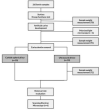Ultrasound device as a minimally invasive approach for caries dentin removal
- PMID: 35262554
- PMCID: PMC9645142
- DOI: 10.1590/0103-6440202203878
Ultrasound device as a minimally invasive approach for caries dentin removal
Abstract
The aim of this study was to evaluate the efficacy of an ultrasound device and the dentin surface morphology after removal of the caries dentin lesions by removal rate and scanning electron microscopy (SEM). The Knoop hardness test on the bovine dentin blocks (n = 20, 4x4x2mm) was performed to standardize the samples and only those with 38 ± 2 KHN were included. The dentin blocks were submitted to induction of artificial caries lesions, using the bacterial model. Strains of Streptococcus mutans and Lactobacillus acidophilus were used for 7 days. The caries dentin lesion was removed for 1 min, according to two methods: G1 - carbide bur under low-speed rotation (control group) and G2 - ultrasound device under refrigeration. For the removal rate, the samples were weighed 3 times: T0 (before induction), T1 (after induction) and T2 (after removal). Morphology evaluation of the residual dentin surface was performed by SEM. Data normality was verified by Shapiro-Wilk test (p ≥ 0.240). T-test for independent samples was applied to evaluate the removal rate. A significance level of 5% was adopted. G2 provided lower removal rate than G1 (G1: 3.68 mg and G2 = 2.26 mg). SEM images showed different morphological characteristics between the groups. G2 showed absent of smear layer, while G1 showed a visible smear layer over the surface. We concluded that ultrasound device provides minimally invasive removal with residual dentin exhibiting open dentin tubules and no smear layer formation and no bacteria, which infer the removal of the infected tissue.
O objetivo deste estudo foi avaliar a eficácia de um dispositivo ultrassônico e a morfologia da superfície dentinária após a remoção da dentina cariada por meio da taxa de remoção e imagens de microscopia eletrônica de varredura (MEV). Foi realizado o teste de dureza Knoop nas amostras de dentina bovina (n = 20, 4x4x2mm) afim de padronizar as amostras e foram incluídas apenas aquelas com 38 ± 2 KHN. As amostras de dentina foram submetidas à indução de lesões artificiais de cárie, utilizando-se modelo biológico contendo cepas de Streptococcus mutans e Lactobacillus acidophilus durante por 7 dias. As lesões foram removidas por 1 min, de acordo com dois métodos: G1 - fresa esférica sob baixa rotação (grupo controle) e G2 - dispositivo ultrassônico sob refrigeração. Para a taxa de remoção, as amostras foram pesadas em três tempos: T0 (antes da indução), T1 (após a indução) e T2 (após a remoção). A avaliação morfológica da superfície residual da dentina foi realizada por MEV. A normalidade dos dados foi verificada pelo teste de Shapiro-Wilk (p ≥ 0,240). Teste T para amostras independentes foi aplicado para avaliar a taxa de remoção. Foi adotado nível de significância de 5%. G2 apresentou menor taxa de remoção que G1 (G1: 3,68 mg e G2 = 2,26 mg). As imagens de MEV mostraram características morfológicas diferentes entre os grupos. G2 mostrou ausência de smear layer, enquanto G1 mostrou grande quantidade de smear layer sobre a superfície. Com base neste estudo in vitro, o dispositivo de ultrassom promoveu remoção minimamente invasiva e dentina residual exibindo túbulos dentinários abertos e mínima formação de smear layer.
Conflict of interest statement
The authors deny any conflict of interest in this paper.
Figures








References
-
- Banerjee A, Frencken JE, Schwendicke F, Innes NPT. Contemporary operative caries management: Consensus recommendations on minimally invasive caries removal. Br Dent J. 2017;223(3):215–222. - PubMed
-
- Banerjee A, Kellow S, Mannocci F, Cook RJ, Watson TF. An in vitro evaluation of microtensile bond strengths of two adhesive bonding agents to residual dentine after caries removal using three excavation techniques. J Dent. 2010;38(6):480–489. - PubMed
-
- Costa AR, Garcia-Godoy F, Correr-Sobrinho L, Naves LZ, Raposo LHA, de Carvalho FG, et al. Influence of different dentin substrate (Caries-affected, caries-infected, sound) on long-term μTBS. Braz Dent J. 2017;28(1):16–23. - PubMed
-
- Aggarwal V, Singla M, Yadav S, Yadav H. The effect of caries excavation methods on the bond strength of etch-and-rinse and self-etch adhesives to caries affected dentine. Aust Dent J. 2013;58(4):454–460. - PubMed
-
- Ricketts D, Lamont T, Innes NP, Kidd E, Clarkson JE. Operative caries management in adults and children. Cochrane Database Syst Rev. 2013 - PubMed
MeSH terms
LinkOut - more resources
Full Text Sources
Medical
Molecular Biology Databases

